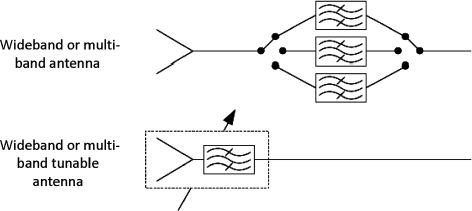Chapter 7Transmitter/Receiver Analog Front End1
7.1. Introduction
Starting from software-defined radio (SDR) architecture, this chapter deals with the receiver radio frequency (RF) (or analog) front end. It is therefore assumed that some analog part is retained in the receiver. Thus, three fundamental parts are studied in this chapter: antennas, power amplifiers, and converters. The SR technology actually imposes new constraints on the three steps (bandwidth, linearity, dynamic) and it is therefore necessary to rethink the design. However, this chapter does not address mixers, frequency synthesizers, and filters.
7.2. Antennas
7.2.1. Introduction
To analyze the electromagnetic environment and adapt its operation, the cognitive radio (CR) system is brought to discriminate the radio signals spectrally and spatially. Spatial discrimination is to select a signal according to its direction of arrival. It requires a directive antenna of the array type, an antenna capable of steering its beam(s) in the desired direction(s). Spectral discrimination requires, in turn, using a broadband or a multiband antenna. The frequency selection of the signals is performed using band-pass filters or directly by the antenna if the latter is tunable. Figure 7.1 shows the associated architectures.
Figure 7.1. Possible architectures for an RF front end for spectral discrimination

The implementation ...
Get Radio Engineering: From Software Radio to Cognitive Radio now with the O’Reilly learning platform.
O’Reilly members experience books, live events, courses curated by job role, and more from O’Reilly and nearly 200 top publishers.

